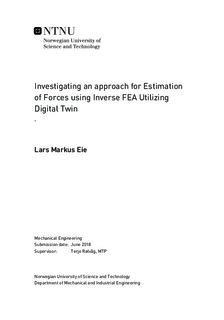| dc.description.abstract | The industry is moving quickly into a new era, the era of Internet of Things and Industry
4.0. This means that everything should have some sort of virtual information database
where information such as environmal factors should be stored. For embedded systems
the connection to internet is not a very far-fetched idea, but for structural object, such
as a bridge or a windmill, the method for connecting it to internet is not that straight
forward. The solution to this is the so called Digital Twin. A digital twin is an as-built
Finite Element Model (FEM) which runes a continous real-time Finite Element Analysis
(FEA) by using sensor inputs from the real life structure. The information will then be
stored, and it is possible to view the load history on the structure or each substructure
within a superstructure. Using a Digital Twin the predictive maintenance can hopefully
be estimated with great confidence. In this thesis it has been investigated and approach
for how to estimate a force (its direction and magnitude), and how to further implement
this in Fedem. A comparison of real strain gauge values versus the ones calculated from
the input force in Fedem has been done. | |

